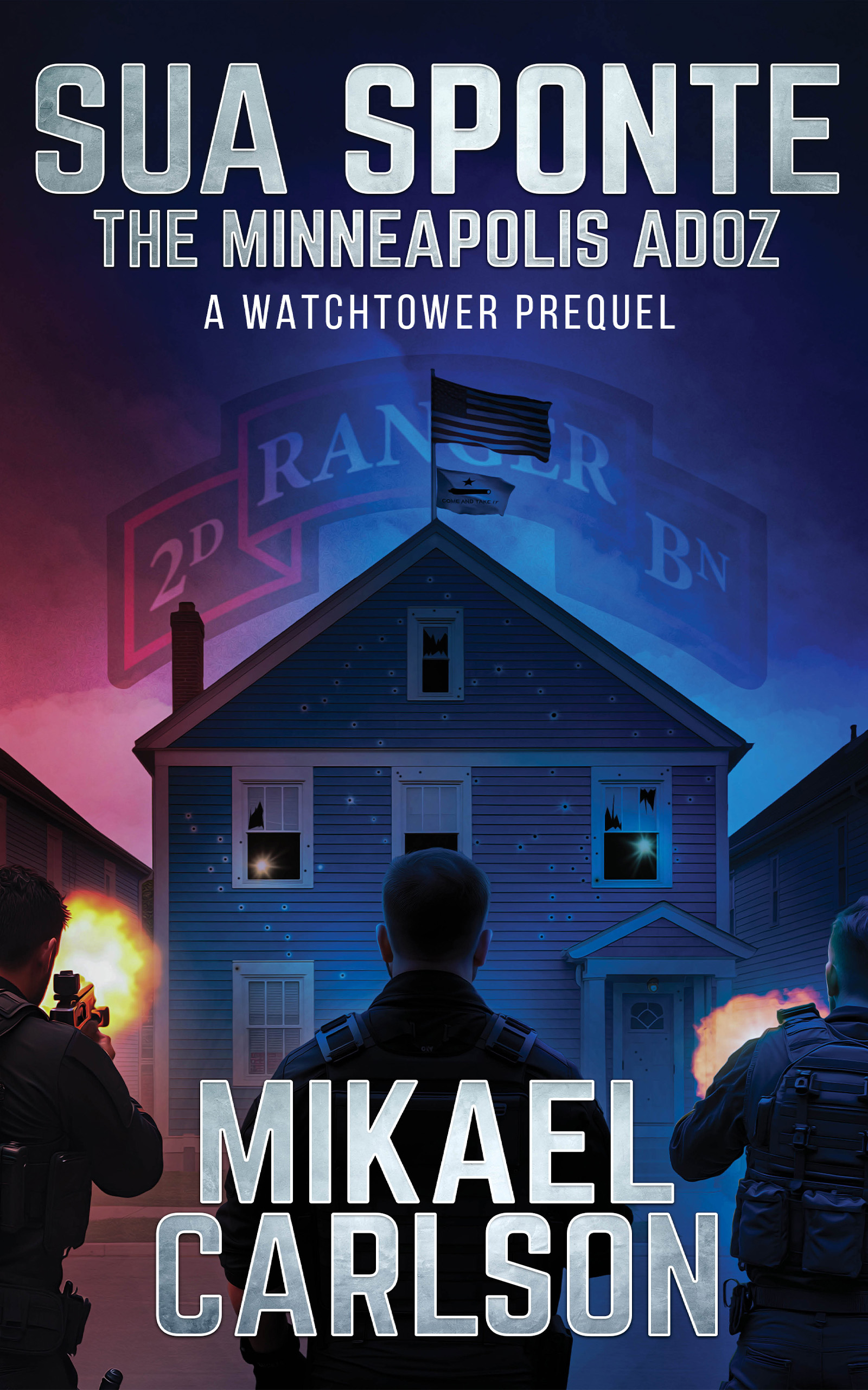
PROLOGUE
SSG Emmit “Chicago” Haskins
Near the Iraq Border
Syria
This place is the armpit of the world. Sure, that can be said about a lot of backwater countries and inhospitable landscapes. Many of the soldiers Emmit knows say that about the Army posts they live on. Hell, Fayetteville, North Carolina, used to be called “Fayettenam” because of all the violence in the city outside of Fort Bragg. But this is different.
Al-Tanf Garrison is a key U.S. military outpost near the borders of Iraq and Jordan in southeastern Syria. Originally set up to train and support anti-ISIS fighters, its location on a major highway makes it strategically important in the campaign against the Iranian-backed militias. They need an established land corridor from Tehran to Damascus and Beirut to conduct and support their operations. The Rangers are posted here to deny them use of that route.
Not that anyone back home cares. The Syrian mission is all but unknown to the American public. Emmit is fairly certain the politicians want it that way. There are only around nine hundred U.S. soldiers, not counting contractors, operating in all of Syria. Most are in the North to support Syrian Democratic Forces, while his unit of Rangers holds down the South with a few coalition troops and the Maghawir al-Thawra rebel group.
Most of Staff Sergeant Haskins’s time here has been pretty boring. It’s a lot of downtime spent with the guys in his squad. Sure, there are missions, but nothing like a lot of the veterans of this unit saw in Iraq and Afghanistan. The end of their deployment is growing closer. In a couple of short weeks, they will be on a plane home. To a man, all of them hoped things would stay quiet. Then, ISIS got frisky.
An Iranian suicide drone flew low over fencing into the base and struck a maintenance facility, killing a contractor and wounding several Rangers. It was a coordinated attack that targeted a number of bases in the country. It deserved a response.
Two platoons are convoying to a nearby village where Reaper drones surveilling the area reported the ISIS fighters fled after launching the attack. It smells like a trap, but the commander decided to press forward with the mission anyway. About two clicks from the village, their worst fears are realized.
IEDs eviscerate the road, and the center of the convoy is rocked by RPG fire. Movies do a great job with visual effects, but the reality is far more brutal. Films can’t capture the feeling of the concussion from a blast wave and what it does to your insides. A screen can’t fully convey the assault on the senses – sight, sound, smell…it’s a fight to keep your senses and think clearly. That’s what good soldiers in combat are trained for and mentally condition themselves to do – fight through all that to make decisions.
“Ho-ly shit!” one of his men shouts. It sounded like Tulsa up in the turret.
The MRAP in front of them gets hit by an RPG after the IED takes out the vehicle in front of it. There are almost a hundred meters between the convoy vehicles, meaning there is more than a kilometer of separation between the lead and trail vehicles.
Two guys in the heavily armored vehicle are thrown more than twenty feet from the road. Fire is pouring down on them from small rises on either side of the road. It’s a classic ambush, and they drove right into it. Why they didn’t have a drone reporting what lay ahead is anyone’s guess. It’s a good question for the after-action report.
“Floor it. Get to that MRAP,” Haskins orders as he reaches for the mic on his SINCGARS. The Single Channel Ground and Airborne Radio System is a VHF combat net radio his unit is using for voice and data communications.
“Blackjack One-Six, This is Blackjack One-One,” he barks. “Two men are down and in the open! Need suppression and CASEVAC!”
“This is One Actual, roger,” his platoon leader acknowledges.
Private First Class O’Leary, whom the team has come to call “Nashville” after his hometown, stops their up-armored Humvee short of the burning MRAP. His remaining squad members pour out of their vehicles, identifying and suppressing enemy fire while maintaining defensive positions.
The enemy fire is withering. Emmit looks around. This is a bad place to be. They’re stopped in the kill zone and are easy targets for the ISIS fighters. Dust and smoke choke the air as Emmit ducks behind his HMMWV to dodge the bullets whizzing past him.
“Blackjack One-One, this is Blackjack Six Actual. Get out of that kill zone. Now!”
“Did he just order us to leave men behind?” Specialist Hibbard asks. Emmit just calls him “Tulsa” for brevity.
Emmit shakes his head in disgust. “Blackjack Six, negative. I have men down.”
“You can’t help them, One-One. You’re going to get your men killed. Air support is en route. Now, get out of there before you’re cut to pieces!”
“Not without my men, sir!”
“It’s an order, Staff Sergeant!”
Emmit drops the radio. His commander isn’t wrong. The SOP is to move out of the kill zone as quickly as possible. He stares over the hood of the Hummer and sees Missoula clutching his bleeding leg as he tries dragging Gamecock with one arm to a defilade to his rear. It’s drawing a lot of enemy attention. Puffs of dirt are kicked up with every bullet strike, and they are uncomfortably close to them.
“Chicago, we can’t leave them!” one of his team leaders shouts.
“Yeah, no shit,” Emmit retorts. “How good’s that pitcher arm of yours, Atlanta?”
He yanks a smoke grenade from his vest, pulls the pin, and lobs it between the downed soldiers and the enemy. “Nolan Ryan ain’t got shit on me.”
Atlanta repeats the throws to the left and right of his first. The thick gray cloud belching out of the canisters buys precious seconds. ISIS can’t hit what they can’t see, not that it has stopped them from trying.
Emmit slaps a fresh mag into his M4 and fires controlled bursts toward the enemy positions. Most of his Rangers, including Nica, Nashville, Tulsa, Bronx, Hollywood, and Atlanta, join him. Their accurate fire suppresses the enemy marksmen on bluffs to both sides of the road.
His heart is pounding out of his chest. He sprints through the open ground, sliding next to Missoula, who is in serious pain, having reached the shallow defilade with Gamecock. The Montanan is as tough as nails. Hailing from a long list of ranchers, he’s no-nonsense.
“Fancy meeting you here. I told you to keep your arms and legs in the train car at all times. See what happens when you don’t listen?”
“Ha, ha.”
“All right, let’s get you out of here.”
He hoists Missoula onto his shoulder in a fireman’s carry, gritting his teeth against the weight. The volume of fire picks up from both sides. Frustrated, two ISIS fighters rush down from the small rise, their AK-47s raised. Emmit’s squad fires controlled bursts and drops both of them. That was dumb.
“Take care of him,” Emmit says, laying Missoula down next to their Humvee. I’ll be right back.”
“Chicago!” Nashville shouts. “Aw, hell….”
This isn’t suicide, but it’s close. The ISIS fighters have figured out what’s going on and are intent on stopping Emmit from retrieving their trophies. The covering fire is the only thing keeping them at bay…and him alive.
He checks on Gamecock. The Ranger is unconscious and has blood trickling from his mouth. It looks like he’s breathing, but there’s no time to ensure that. Not that it matters. He isn’t leaving anyone behind, alive or dead.
Chicago grabs him by his body armor and drags him back to the road. It’s slower than the carry but presents a smaller target for the terrorists to shoot at. Most of them are firing in his direction. Countless rounds slam into the dirt beside him.
Gamecock gets hoisted into the vehicle as Chicago climbs into the front. The rest of his squad mounts their vehicles while the combat lifesaver works on applying a tourniquet to Missoula’s leg. He isn’t paying any attention to Gamecock. That isn’t a good sign.
“Get us out of here!” Emmit commands.
The vehicle lurches backward just as two RPGs scream past them to the front.
“Oh, shit! I could read the serial number on that thing!” Tulsa screeches.
That was close. Chicago sees three more men pop up on the bluff and pull launchers up to their shoulders. He’s about to shout at his men to engage them when they evaporate into pink mist. He saw the results before he heard the sound.
The AC-130J “Ghostrider” is a heavily armed, long-endurance, ground-attack Air Force aircraft designed for close air support, air interdiction, and armed reconnaissance. It has a 25mm GAU-12 Equalizer Gatling gun, a 40mm Bofors cannon, and a 105mm howitzer. The Gatling gun took out the guys with the RPGs, and now the “Angel of Death” is pounding both sides of the road with the cannon and howitzer.
Chicago leans out, firing his last rounds to cover the retreat. Not that he needs to. The ISIS terrorists not already wiped out by the Ghostrider will run, and they will only die tired. Air dominance is a beautiful thing, and he wouldn’t be surprised if the F-22 Raptors, which technically aren’t in-country, are flying cover for the gunship.
“You’re a crazy bastard, Chicago,” Bronx says from the back. “You must have really wanted that Silver Star before you get out of here.”
He doesn’t answer. The Silver Star Medal is the third-highest military combat decoration. It’s awarded to members of the U.S. military who display exceptional gallantry in enemy action. That’s not at all why he did it.
This squad is his family, outside of his little sister. He doesn’t want to see a video uploaded of them parading around the body of a fellow Ranger and then desecrating it. He’s sure that the families of these men wouldn’t want to see that either. “Leave no man behind” isn’t just a phrase. It’s part of the warrior ethos. If nothing else, Emmit satisfied that pledge.
The convoy is going to return to base. Chicago isn’t looking forward to what happens next. This mission is over, and the Army will have to report the casualties to the American people. Worse, he disobeyed a direct order from his commanding officer. There are going to be consequences for that. Forget a medal…he will be lucky to avoid a court-martial when the dust settles on this debacle.
a year later
CHAPTER one
CHIEF VANESSA Campbell
City Hall Conference Room
Minneapolis, Minnesota
The police chief enters the impressive pink granite structure that occupies an entire city block between Third and Fourth Avenues and Fourth and Fifth Streets. Vanessa Campbell has always admired the massive five-story building and its soaring clock chime tower that was once heralded as the largest public timepiece in the world.
The exterior, with its arched entryways, turrets, and steep roof pavilions, exhibits Romanesque design features. The Fourth Street entrance leads her into a five-story atrium with a stained-glass window skylight illuminating marble walls and a ceremonial staircase. At its center is the massive “Father of the Waters” statue. The building has been remodeled and expanded several times since its opening, but it has never managed to lose its charm. The same cannot be said for some of the people who work here.
She enters the conference room just as she does every Monday morning. This weekly meeting has been on the calendar at the mayor’s insistence since he took office. You would think the man would show up on time for it. It looks like today isn’t that day.
“Good morning, everyone.”
“Chief,” they all say in unison.
Following the fallout from the death of George Floyd in 2020, the department was reorganized into three administrative bureaus: Patrol, Investigations, and Professional Standards. Each is led by a deputy chief, with the Patrol Bureau further divided into five precincts with a commander given the rank of inspector. The revamped structure was designed to be decentralized, giving each precinct and bureau a degree of independence with policing. The jury is still out on whether it’s a net benefit to the community.
“We all know what the hot topic is for today’s meeting, so we might as well get it out of the way.”
“Should we wait for the mayor?” one of the deputy chiefs asks.
“We’re already five minutes past the start. The mayor can catch up.”
Vanessa would wait for most people, but their “fearless” leader is a different story. He hates cops and doesn’t hold back in showing his resentment about the department. The chief is convinced she would have been sacked long ago if she weren’t a minority woman. Her merits aren’t saving her job in this city. Her skin color is. At least, that’s her belief.
Everyone around the table knows the story of the incident at this point, but the recap does fill in some details. A black man held up a convenience store in the downtown area and assaulted the clerk when he tried to fight back. The man is okay, but he did get a serious laceration to his scalp. A 9-1-1 call came in, and officers responded. The first patrolman to arrive on the scene shouted commands that were naturally disobeyed.
The subject fled the area on foot, knocking an older woman to the ground as he fled. She required hospitalization, and the man was finally tackled a couple of blocks from the robbery scene. After a struggle, the officer disengaged and drew his taser. The man was armed with a knife and was threatening the officer and other bystanders. After the subject failed to heed commands, the patrolman fired his taser when the suspect lunged for him.
In the grand scheme of things, it was a textbook way to handle the situation. The officer didn’t use deadly or excessive force on a noncompliant criminal. Unfortunately, there are entire groups of people who only see a white cop tasing a black man. Since the video the news is playing is completely without context, she can almost understand why people are upset.
“The wall-to-wall national media coverage isn’t helping,” Otto Goldberg moans. “They relish dragging old skeletons out of the closet, and we have a lot of them. Perhaps if you embrace the community policing model more, unfortunate incidents like this wouldn’t happen.”
The assistant chief of community trust is a new position, and the man who is filling it is the bane of Vanessa’s existence. Goldberg commands the Constitutional Policing Bureau, the Internal Affairs Bureau, and the restructured Professional Standards Bureau. Among his duties are serving as a community liaison to implement and achieve compliance with the state settlement agreement. While she understands the mandate, he interprets his role as someone who sides with criminals and demonizes the officers on the force. He isn’t overly popular with the officers in the ranks.
“Yes, perhaps we should have given him the key to the city for robbing a convenience store, assaulting the clerk, and knocking an old woman to the ground during the pursuit.”
“There’s no need to be glib, Chief,” Inspector Wilma Sillyere warns. “We need to evaluate whether there was a better way for the officer to handle the situation.”
“Yeah, he could have shot him,” one of the other inspectors mumbles.
“Because shooting an unarmed man would solve our PR problem with the media.”
“He was armed. You’d know that if you had bothered reading the report, Wilma.”
Wilma and Otto are partners in crime, if such a thing can exist on a police force. They both have radically different ideas on how to keep the people of this city safe than suit Vanessa’s tastes. Unfortunately, both are protected by the mayor. The three of them together are the trifecta from hell when it comes to protecting and serving. She needs to move this conversation along before it devolves into something she can no longer control.
“What about the officer in question? What’s his service record like?” Vanessa asks, nodding at the 1st Precinct boss. He opens a file folder and picks up a sheet of paper.
“Impeccable. Officer Eirik Ohlsen was a top graduate of the academy and is a veteran with almost seven years on the force. He is well-regarded by the community and volunteers for a program that mentors disadvantaged children. Most of them are minorities.”
“That doesn’t sound like someone they will easily paint as a closet racist,” Vanessa concludes.
“Like that will stop people,” Inspector Sillyere argues. “The truth is, because of his actions, we’re sitting on a powder keg…again.”
“That’s the reason we reorganized this department, as I recall,” Mayor Elliott Thurlow says, walking into the room and taking his seat. “Apparently, we haven’t learned our lesson after what happened with George Floyd. Isn’t that right, Chief Campbell? Or do you not remember?”
Her eyes narrow. “I was on the front line for those riots.”
The mayor wags his chubby finger at her. “I would be careful calling them riots or characterize the protests of our citizens as anything related to warfare. Don’t you agree?”
Whether they were protests or riots depends on which side of the prevailing narrative someone falls. Either way, the demonstrations and civil unrest that erupted following George Floyd’s death rocked the city and the nation. Video footage showed Floyd repeatedly saying, “I can’t breathe,” which became a rallying cry. While the mayor is correct in saying that many protests were peaceful, the ones here were not. There were a number of reports of looting, property damage, confrontations between protesters and law enforcement, and arsons, including the torching of the 3rd Precinct police station.




Comments
Gritty stuff but very…
Gritty stuff but very believable and clearly well-researched. Great for military buffs who like to feel they're in the thick of the action. An exciting start that sets the tone for the rest of the book.
Strong characterization and…
Strong characterization and pacing. Dialogue shines.
Great start and great…
Great start and great premise! I love the action, and it's great dialogue.